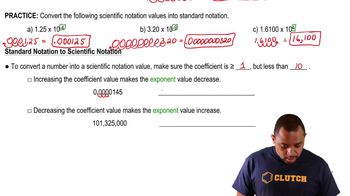Complete and balance the following nuclear equations by supplying the missing particle: (d) 5826Fe + 2 10n¡6027Co + ?
Ch.21 - Nuclear Chemistry

Brown15th EditionChemistry: The Central ScienceISBN: 9780137542970Not the one you use?Change textbook
Chapter 21, Problem 32
Write balanced equations for each of the following nuclear reactions: (a) 23892U + 10n → g + 23992U. (b) 168O + 11p → a + 179N. (c) 188O + 10n → b- + 199F.
 Verified step by step guidance
Verified step by step guidance1
Step 1: Identify the type of nuclear reaction for each equation. For example, determine if it's a neutron capture, alpha decay, beta decay, or another type.
Step 2: For each reaction, apply the law of conservation of mass and atomic numbers. This means the sum of mass numbers (top numbers) and atomic numbers (bottom numbers) on the left side must equal the sum on the right side.
Step 3: For reaction (a), identify the missing particle 'g'. Use the conservation laws to find the mass number and atomic number of 'g'.
Step 4: For reaction (b), identify the missing particle 'a'. Again, use the conservation laws to determine the mass number and atomic number of 'a'.
Step 5: For reaction (c), identify the missing particle 'b'. Use the conservation laws to find the mass number and atomic number of 'b', considering that a beta particle (b^-) is an electron with a mass number of 0 and an atomic number of -1.
Key Concepts
Here are the essential concepts you must grasp in order to answer the question correctly.
Nuclear Reactions
Nuclear reactions involve changes in an atom's nucleus and can result in the transformation of elements. They typically include the interaction of particles such as neutrons, protons, and alpha particles, leading to the emission of radiation or the formation of new isotopes. Understanding the types of nuclear reactions, such as fusion and fission, is essential for balancing equations in nuclear chemistry.
Recommended video:
Guided course

Nuclear Binding Energy
Balancing Nuclear Equations
Balancing nuclear equations requires ensuring that both the mass number and atomic number are conserved during the reaction. This means that the sum of the mass numbers and the sum of the atomic numbers on the reactant side must equal those on the product side. This principle is crucial for accurately representing the transformation of elements and isotopes in nuclear reactions.
Recommended video:
Guided course

Balancing Chemical Equations
Notation in Nuclear Chemistry
In nuclear chemistry, isotopes are represented using a notation that includes the element's symbol, atomic number, and mass number. For example, 238<sub>92</sub>U indicates uranium with a mass number of 238 and an atomic number of 92. Understanding this notation is vital for interpreting and writing balanced nuclear equations, as it provides essential information about the particles involved in the reactions.
Recommended video:
Guided course

Standard Notation to Scientific Notation
Related Practice
Textbook Question
Textbook Question
Complete and balance the following nuclear equations by supplying the missing particle: (e) 23592U + 10n¡13554Xe + 2 10n + ?
Textbook Question
Some watch dials are coated with a phosphor, like ZnS, and a polymer in which some of the 1H atoms have been replaced by 3H atoms, tritium. The phosphor emits light when struck by the beta particle from the tritium decay, causing the dials to glow in the dark. The half-life of tritium is 12.3 yr. If the light given off is assumed to be directly proportional to the amount of tritium, by how much will a dial be dimmed in a watch that is 50 yr old?
1
views
Textbook Question
It takes 4 h 39 min for a 2.00-mg sample of radium-230 to decay to 0.25 mg. What is the half-life of radium-230?
